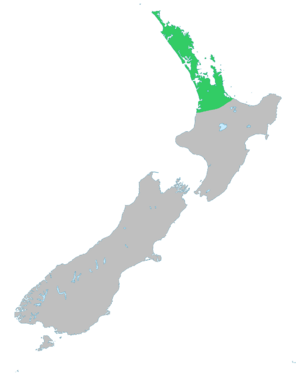Dwarf cabbage tree facts for kids
Quick facts for kids Dwarf cabbage tree |
|
|---|---|
 |
|
| Cordyline pumilio, Auckland Botanic Gardens | |
| Scientific classification | |
 |
|
| Natural range of C. pumilio (green) |
The Cordyline pumilio is a special plant from New Zealand. People often call it the dwarf cabbage tree or pygmy cabbage tree. Its Māori names are tī koraha or tī rauriki. This plant is a type of shrub with narrow leaves. It is endemic to New Zealand, meaning it naturally grows only there.
It usually grows up to 1 metre (about 3 feet) tall. Sometimes, it can even reach 2 metres (about 6.5 feet)! Its long leaves can make it look like a grass or a sedge. You can find C. pumilio in the northern part of New Zealand's North Island. It likes to grow under light forests and in scrubby areas. Long ago, the Māori people grew this plant. They used its roots as a source of energy and to make other foods taste sweeter.
Contents
What is Cordyline pumilio?
Cordyline pumilio is the smallest of New Zealand's five native Cordyline plants. The most common one is the common cabbage tree (C. australis). This tree can grow up to 20 metres (about 65 feet) tall. It has a thick trunk and leaves that look like swords.
Another type is the forest cabbage tree (C. banksii). It has a thin, bending trunk. The mountain cabbage tree (C. indivisa) is also very pretty. It can grow up to 8 metres (about 26 feet) high. This plant has a round top of wide leaves, which can be 1 to 2 metres (3 to 6.5 feet) long. In the far north of New Zealand, C. pumilio might have mixed with C. australis. This mixing is called hybridisation.
Where do the names come from?
The name Cordyline comes from an Ancient Greek word. This word means "club." It refers to the plant's thick underground stems, called rhizomes. The name pumilio is a Latin word meaning "dwarf." This makes sense because it's the smallest cabbage tree.
Some people say the common name "Cabbage tree" came from early settlers. They might have used the young leaves of similar plants as a substitute for cabbage.
Māori names and uses
The Māori people knew this plant very well. They grew it for its roots and stems, which are full of sugar. They used it long before Europeans discovered and named it. The general Māori word for Cordyline plants is tī. Specific names for C. pumilio include tī koraha and tī rauriki.
How to identify Cordyline pumilio
Cordyline pumilio is a plant that rarely grows taller than 2 metres (about 6.5 feet). It has very narrow leaves. It does not grow into a large tree like C. australis. Often, it flowers when its short stem still has leaves all the way to the ground.
Older plants might have a bare stem up to 1 metre (about 3 feet) long. This stem is usually not very straight and is about 1.5 centimetres (less than an inch) wide. The leaves are long, from 30 centimetres to 1 metre (1 to 3 feet) in length. They are also narrow, about 1 to 2 centimetres (up to an inch) wide. The middle vein of the leaf is easy to see on the underside. The edges of the leaves curve slightly backwards.
Flowers and seeds
The plant's flower spike, called a panicle, appears in November or December. It can be up to 60 by 30 centimetres (about 2 by 1 feet) in size. It is very open with thin branches. Small white or bluish-white flowers are scattered along these branches. The small leaf-like parts near the flowers, called bracts, are often tiny and hard to see. The flower petals, called tepals, are narrow and curve backwards. They have three lines or nerves. The part of the flower that receives pollen, called the stigma, is short and has three parts.
Cultural uses by Māori
The Māori people grew Cordyline pumilio in the Waikato district and other parts of New Zealand. They carefully chose young plants and planted them. After about three years, they would dig up the roots. They stacked the roots in small piles and dried them in the sun. As the roots dried, the stringy parts were burned off.
Then, the roots were scraped and baked slowly in an umu or hāngi. This is a traditional Māori earth oven. It took a long time to cook, about twelve to eighteen hours! The cooked roots were either chewed directly. Or, they were pounded, washed, and squeezed to get out the sugar. This sugar was then eaten with fern root as a tasty addition to meals.
Māori people thought C. pumilio tasted better than tī kōuka (C. australis). However, they liked tī pore (Cordyline fruticosa) even more. They had brought tī pore with them from tropical Polynesia.

